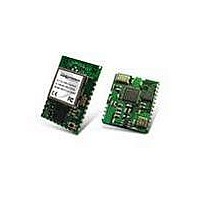WI.232FHSS-250-R Radiotronix, WI.232FHSS-250-R Datasheet - Page 19

WI.232FHSS-250-R
Manufacturer Part Number
WI.232FHSS-250-R
Description
RF Modules & Development Tools 900MHz FHSS Low
Manufacturer
Radiotronix
Datasheet
1.WI.232FHSS-25-FCC-RA-R.pdf
(67 pages)
Specifications of WI.232FHSS-250-R
Lead Free Status / RoHS Status
Lead free / RoHS Compliant
Other names
WI232FHSS-250-R
WI.232FHSS-25-R/ WI.232FHSS-250-R DATASHEET
2.6. Resetting Module to Factory Defaults
It may be necessary to reset the non-volatile registers to their factory defaults. To reset the module to
factory defaults, hold the command line low and cycle power to the module. The command line must
remain low for a minimum of 600ms after resetting the module. Once the command line is released, the
module’s non-volatile registers will be reset to factory defaults.
2.7. Compatibility Mode
The Wi.232FHSS-250-R operates at a much narrower receive bandwidth (200kHz) than the Wi.232FHSS-
25 (600kHz). When the Wi.232FHSS-25 transmits, it deviates well outside the receiver bandwidth of the
Wi.232FHSS-250-R. To address this problem, v1.0.5 and later Wi.232FHSS-25 firmware and all
Wi.232FHSS-250-R’s support a compatibility mode. This allows both modules to communicate effectively
with each other.
When enabled, compatibility mode reduces the maximum RF data rate to 76.8kbps, reduces the
Wi.232FHSS-25’s deviation to 80kHz, and reduces the Wi.232FHSS-25’s receiving bandwidth to 200kHz.
All UART baud rates are supported, although the RF data rates associated with baud rates 31250, 38400,
57600, and 115200 will be diminished.
2.8. Automatic Gain Control and Manual Gain Control
Automatic gain control is a feature exclusive to the Wi.232FHSS-250-R module. For both modules, the
gain setting of the receiver low noise amplifier (LNA) is adjustable.
By default, the Wi.232FHSS-25 module is configured for maximum receiver sensitivity. Similarly, the
Wi.232FHSS-250-R is factory-configured to use its internal automatic gain control (AGC) circuit to manage
receiver sensitivity. Reducing the gain increases the linearity of the receiver, but reduces maximum
sensitivity; increasing the gain does the opposite. Generally speaking, higher linearity (increased third
order input intercept point, IIP3) will give improved performance in high-interference environments; high
gain yields better performance in low-interference environments.
The Wi.232FHSS-250-R contains an AGC circuit that manages these settings automatically, and it should
be used whenever possible. However, when attempting to make analog RSSI measurements, fixing the
LNA gain will produce more meaningful results. Digital RSSI readings are internally compensated and may
be taken with AGC enabled.
Table 6, Example Exception Masks
Exception Mask
0x08
0x10
0x20
0x40
0x60
0xFF
Exception Name
Allows only EX_BUFOVFL and EX_RFOVFL to trigger the EX pin
Allows only EX_WRITEREGFAILED to trigger the EX pin
Allows only EX_NORFACK to trigger the EX pin
Allows only EX_BADCRC, EX_BADHEADER, EX_BADSEQID, and EX_BADFRAMETYPE
exceptions to trigger the EX pin
Allows EX_BADCRC, EX_BADHEADER, EX_BADSEQID, EX_BADFRAMETYPE, and
EX_NORFACK exceptions to trigger the EX pin
Allows all exceptions to trigger the EX pin
18
Revision 1.1.0













